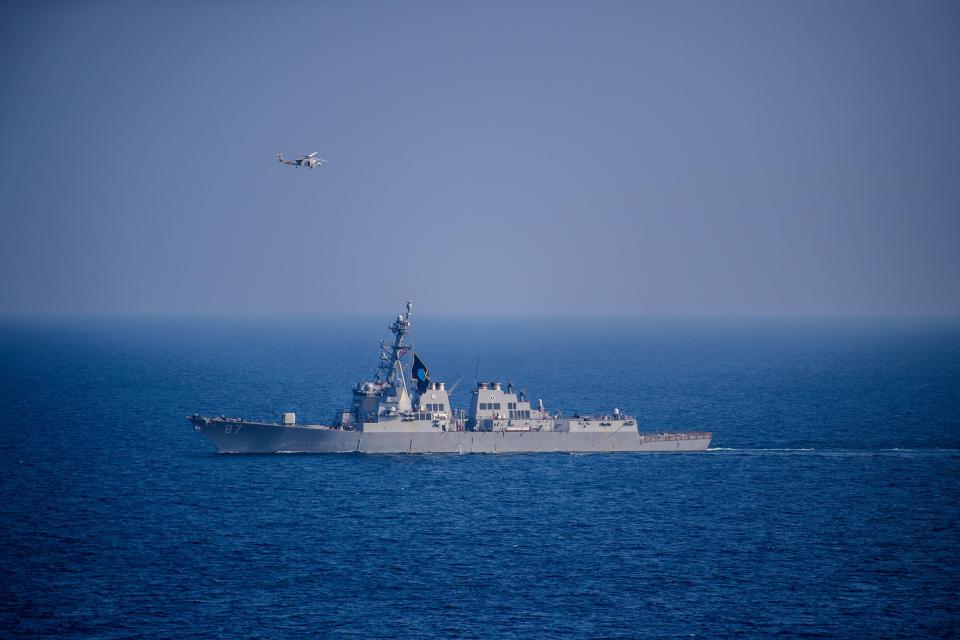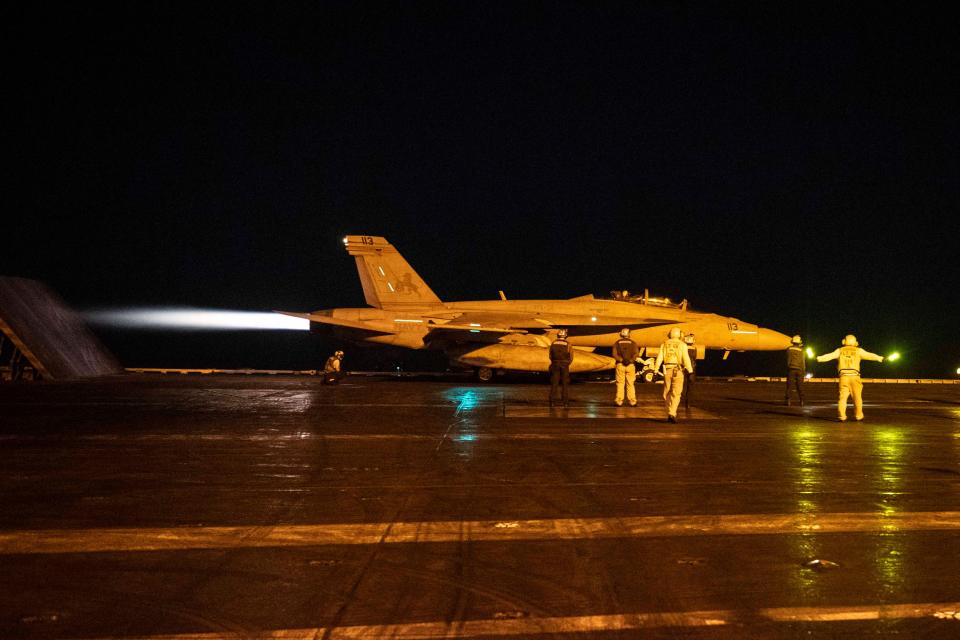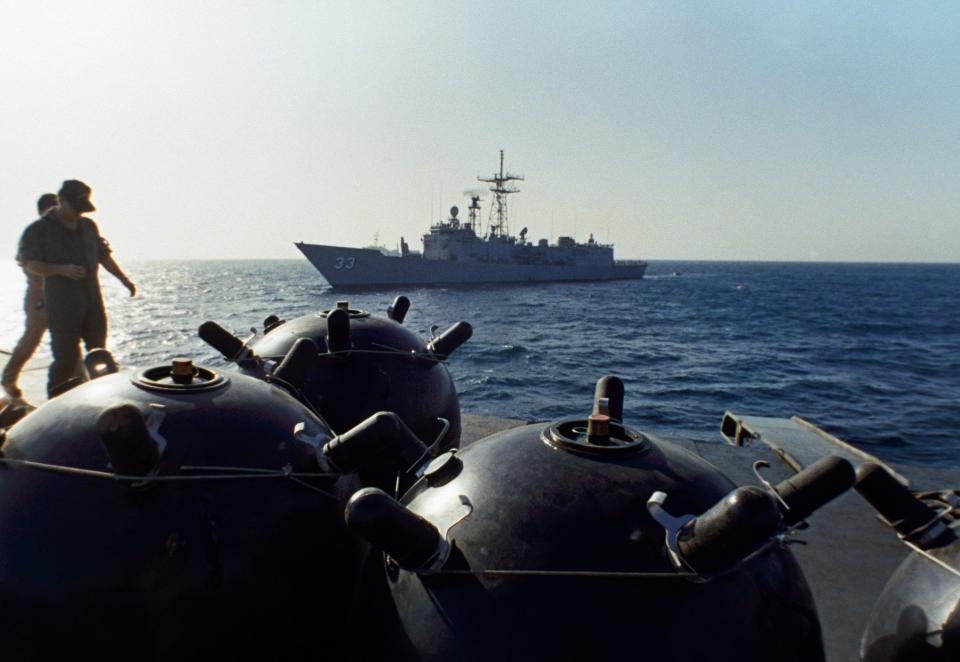Destroyer captain says the US Navy's Red Sea fight is more intense than even the Tanker War in the 1980s
The US Navy's counter-Houthi mission has been described as its most intense combat since World War II.
The captain of a destroyer that deployed to the Red Sea said it surpasses the dangerous Tanker War.
That conflict was part of the broader Iran-Iraq War of the 1980s.
The US Navy has spent months battling Houthi missiles and drones threatening warships and civilian vessels alike in a high-tempo operating environment that has been described as the most intense combat the sea service has seen in nearly eight decades.
One American warship very familiar with the Houthi threat is the destroyer USS Mason, which just returned to its homeport after a restless, monthslong deployment protecting key shipping lanes in the Red Sea and Gulf of Aden.
The Mason's crew, like those of other ships of the Dwight D. Eisenhower Carrier Strike Group that left the region a few weeks ago, has been deeply involved in the counter-Houthi mission, and they have scored intercepts against threats like one-way attack drones and anti-ship ballistic missiles. They also "escorted and saved" more than two dozen merchant vessels as they navigated dangerous waters, the Navy said this month.
Cmdr. Justin Smith, the Mason's commanding officer, told Business Insider in a recent interview that the deployment was "highly successful," noting that it involved "unprecedented sustained combat operations" that have been "unmatched since World War II."
"I am extremely proud of my crew's performance and the resiliency throughout the entire deployment," he added.
Different threat environments
The Navy has seen plenty of combat since 1945 — including Korea, Vietnam, and conflicts in the Middle East — but much of it was power projection ashore rather than intense combat at sea between ships and even fleets as WWII had seen. One rare exception to this was the Tanker War that was a part of the larger Iran-Iraq War in the 1980s.

The Tanker War, the spillover from their brutal land war, saw several years of Iranian and Iraqi attacks on merchant vessels in the Persian Gulf. US warships eventually deployed to the region from 1987 to 1988 to provide escort for Kuwaiti tankers reflagged as American vessels that Tehran had been targeting, an operation that has similarities with the US-led task force trying to defend merchants from Houthi attacks.
The American warships faced a difficult threat environment that consisted of mines and also anti-ship missiles. One such missile that was fired by an Iraqi fighter jet hit the frigate USS Stark, killing more than three dozen Navy personnel. Iraq called it an accident as the Iranians celebrated; the US cut off ties with Iran in 1980 after its revolution and provided some support to Iraq during the conflict.
The Tehran-backed Houthis have fired anti-ship cruise missiles in their ongoing campaign just like Iran did during the conflict in the 1980s. But the rebels have introduced other weapons as well. The group became the first group to use anti-ship ballistic missiles in combat and have routinely fired these weapons into the Red Sea and Gulf of Aden. One attack on a merchant vessel killed several civilians.
The commanding officer of another destroyer deployed to the Red Sea, USS Carney, described anti-ship ballistic missiles to BI as a challenging threat because they're so fast and dynamic. In this conflict, the US Navy scored the first successful interceptions of ballistic missiles fired towards ships.
Smith, the Mason captain, said the Navy is facing a different operating environment in the Red Sea than it did in the Persian Gulf back in the 1980s.

"You are facing higher-end threats, you are facing being inside of a weapons engagement zone for days and months at a time," Smith said.
One Navy sailor who served in the combat-information center on the destroyer USS Gravely during its deployment told BI that the crew might only have seconds to respond to an incoming missile depending on its speed.
The Houthis are an unpredictable enemy, and missile launches can happen at any moment. In this environment, sailors have had to maintain a high-readiness state around the clock as they scanned radar and other sensors for signs of incoming attacks.
Beyond anti-ship missiles, the Houthis have also demonstrated their effectiveness at using drone boats packed with explosives to strike merchant vessels. These vessels are largely defenseless, unlike the US warships in the area, which so far haven't been hit despite some close calls.
"I think the difference between the Tanker War and what we are doing in the Red Sea is that longer, enduring threat and the ability to be inside of a larger area — always having that risk of being targeted or having an engagement that's going to have to take place," Smith said.
"The challenges — from detection and the sustainment, and the watch teams and the readiness — is a lot higher," he said. "And that's why I compare that more so to World War II than, I'd say, even outpacing what was seen during the Tanker War."
Intense air-defense battles
Archer Macy, a retired Navy admiral who served on the amphibious transport dock USS La Salle during the Tanker War, emphasized the high level of readiness required of the American warships in the Red Sea.

"They have to be ready to shoot on a moment's notice," Macy, now a senior associate at the Center for Strategic and International Studies' Missile Defense Project, explained. "It's a very high state of readiness, and you have to maintain it."
Specifically from the perspective of the almost non-stop air-defense engagements, the Red Sea fight has definitely been more intense than anything the US Navy has seen since World War II, including the Tanker War, he said.
The Second World War was much more intense given the fleets that were facing off. "What the guys were facing in World War II off of Okinawa with the Kamikazes was a lot more than we have faced in the Gulf," Macy said.
The same can't necessarily be said about air combat or sea operations, though. The Tanker War, for example, included a sea battle in which the US Navy sank three Iranian vessels and damaged five more in what was its largest naval action since WWII.
US aircraft have carried out a number of strikes inside Yemen, targeting rebel facilities, radar sites, weapons, and other assets. But they have done so relatively uncontested and at a slower pace than what was seen during the Vietnam War, where naval aviators flew intense bombing campaigns under the threat of Soviet-made surface-to-air defenses.
"Certainly, it's the most intense air-defense challenge we've encountered in a long time," Macy said of the Red Sea fight. But, he added, "it does not match up to World War II."
Read the original article on Business Insider

